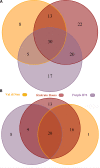Phenolic Profile and Susceptibility to Fusarium Infection of Pigmented Maize Cultivars
- PMID: 30154815
- PMCID: PMC6102558
- DOI: 10.3389/fpls.2018.01189
Phenolic Profile and Susceptibility to Fusarium Infection of Pigmented Maize Cultivars
Abstract
Maize is a staple food source in the world, whose ancient varieties or landraces are receiving a growing attention. In this work, two Italian maize cultivars with pigmented kernels and one inbred line were investigated for untargeted phenolic profile, in vitro antioxidant capacity and resistance to Fusariumverticillioides infection. "Rostrato Rosso" was the richest in anthocyanins whilst phenolic acids were the second class in abundance, with comparable values detected between cultivars. Tyrosol equivalents were also the highest in "Rostrato Rosso" (822.4 mg kg-1). Coherently, "Rostrato Rosso" was highly resistant to fungal penetration and diffusion. These preliminary findings might help in breeding programs, aiming to develop maize lines more resistant to infections and with improved nutraceutical value.
Keywords: FER; Fusarium; anthocyanins; flavonoids; metabolomics; phytoalexins.
Figures





References
-
- ASFIS (1992). Association Pour la Formation Professionelle de l’Interprofession Semences, Description of Components and Varieties of Maize. Paris: ASFIS.
-
- Bello-Pérez L. A., Carmelo-Méndez G. A., Agama-Acevedo E., Utrilla-Coello R. G. (2015). Effect of nixtamalization process on dietary fiber content, starch digestibility, and antioxidant capacity of blue maize tortilla. Cereal Chem. 92 265–270. 10.1094/CCHEM-06-14-0139-R - DOI
LinkOut - more resources
Full Text Sources
Other Literature Sources

